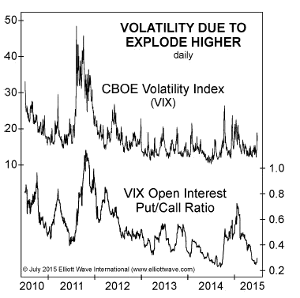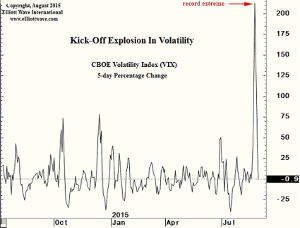For the benefit of the trader with questions about stock market volatility, stemming from conflicting opinions that have been tossed around as of late, the staff at ElliottWave.com addresses both sides of the argument and offers a different take on the subject altogether.
Which one should you heed?
Volatility, volatility, volatility. It's all the financial world can talk about lately...and, well, for good reason. In the past few months, the world's stock markets have endured some of the most gut-wrenching price swings since the 2007-2009 financial crisis.
But for many traders and investors, it's still not clear what this volatility means for the status of the bull market in US stocks.
The reason why said status remains unclear is in large part because the mainstream pundits haven't exactly been consistent with their punditing. (Note: Not a real word.)
Take, for example, this summer. Before US stocks fell off the cliff this August, the market was about as volatile as a yoga retreat. The trend was a slow, calm, and steady ascension to a higher self. In fact, the ultimate fear gauge known as the CBOE Volatility Index (VIX) had dipped below 12 for the first time since 2014.
Now, according to the usual experts, this extended period of market calm was a bullish sign, as these news items from the time explain:
- "Market Volatility Hits 2015 Low...US stock investors haven't had much need for those crash helmets...It's looking like the market could be in for many more months of muted swings." (May 22 CNBC)
- "Investors who paid up for options in anticipation of volatility have lost money in the last three years, so as a result, no one is anxious to do it anymore." (May 13 Wall Street Journal)
- "One of the more bullish indicators has been volatility and it remains that way. Stocks can continue to advance as long as volatility isn't trending upward." (June 23 MarketWatch)
Got it? Low volatility is a bull's best ally.
But wait. Come August, the yoga retreat-like market went from "Om" to "Oh My!" via triple-digit daily leaps and losses (oh yeah, and one quadruple-digit intraday drop on August 24).
So, guess what the experts had to say about this new climate of precipitous price swings? Answer: That it's also bullish.
- "Volatility Is Actually Good For the Stock Market's Returns" (MainStreet August 26)
- "Yes, the Markets are Volatile—That's A Good Thing...Stocks have been too nonvolatile for too long. You don't get up-a-lot markets, big moves fast, without abundant gyrations. You should expect this bull market to raise its tenacious head soon, bucking off all the fear skeptics can hurt at it."
So to summarize: Volatility down means up for stocks. And up is also up?
How about a different take altogether?
See, the mainstream experts did a first-rate job of determining that low volatility is bullish, after years of record calm. And, that high volatility is bullish, after months of record turbulence.
Elliott wave analysis, on the other hand, anticipated a historic reversal from low to high volatility before the tide turned. Here, the July 2015 Elliott Wave Financial Forecast warned "Here Comes High Volatility"
- One gauge of volatility is the CBOE Volatility Index (VIX), a measure of the premium on one-to-three-month S&P options. In essence, the VIX is a sentiment measure, reflecting investors' current state of emotion, from relative calm to outright panic...
- This chart confirms the deep complacency. It shows the open interest in puts relative to calls on the VIX, which indicates the ratio of investors' open option contracts betting on a VIX move. On June 19, the ratio dropped to 0.248, its second lowest level since February 16, 2007 (0.165), when the financials peaked, as just noted.
- Last week, Monday's sell-off appears to be just the start. When the stock market's decline kicks into high gear, volatility will spike to record levels as will the p/c ratio. The era of low volatility will be replaced by head-spinning stock market moves that will shake global stock markets to their foundation.
The next chart captures the dramatic explosion that followed:
So, has a new era of volatility begun? And what does it mean for the US bull market of the past six years?
By the Staff of ElliottWave.com












